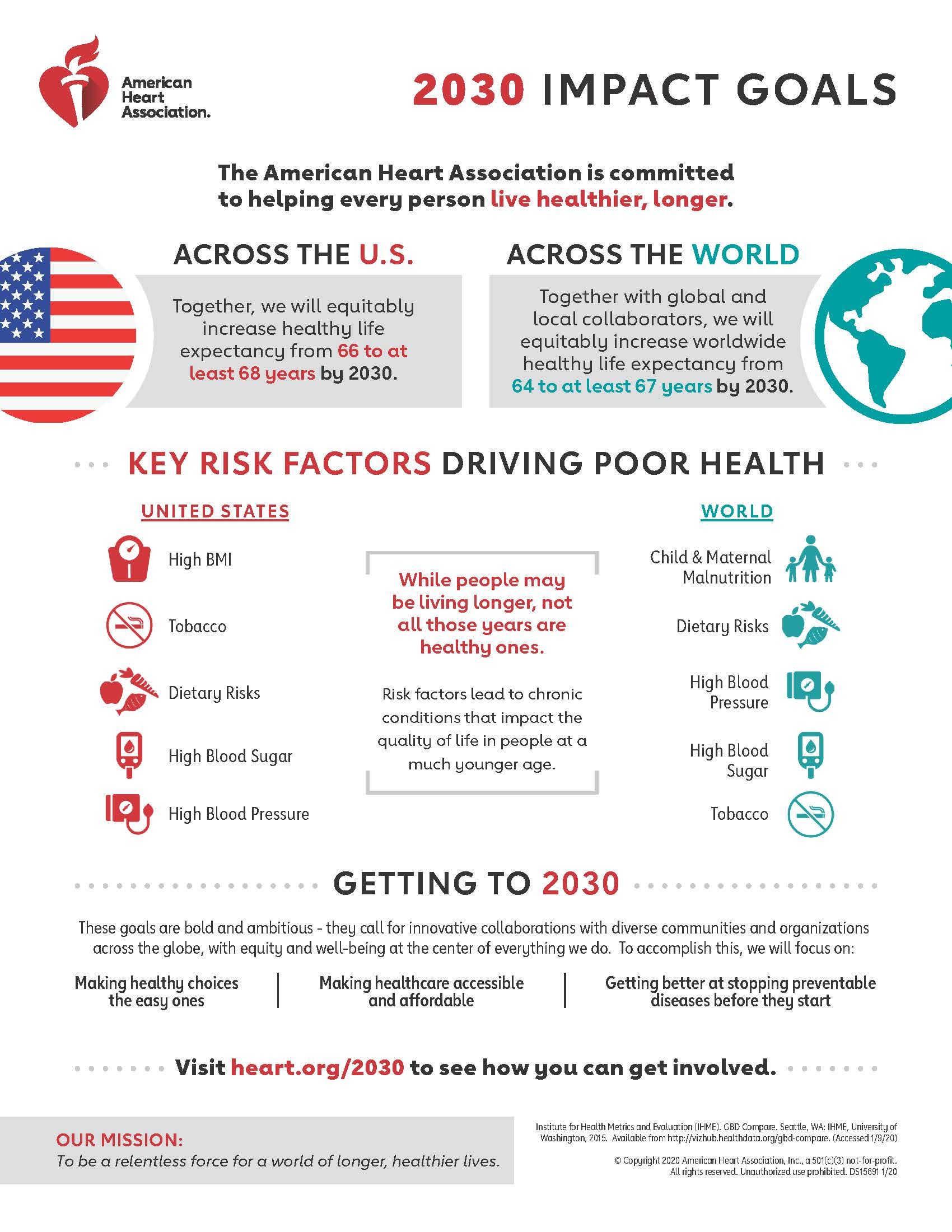- CDC
- Heart Failure
- Cardiovascular Clinical Consult
- Adult Immunization
- Hepatic Disease
- Rare Disorders
- Pediatric Immunization
- Implementing The Topcon Ocular Telehealth Platform
- Weight Management
- Monkeypox
- Guidelines
- Men's Health
- Psychiatry
- Allergy
- Nutrition
- Women's Health
- Cardiology
- Substance Use
- Pediatrics
- Kidney Disease
- Genetics
- Complimentary & Alternative Medicine
- Dermatology
- Endocrinology
- Oral Medicine
- Otorhinolaryngologic Diseases
- Pain
- Gastrointestinal Disorders
- Geriatrics
- Infection
- Musculoskeletal Disorders
- Obesity
- Rheumatology
- Technology
- Cancer
- Nephrology
- Anemia
- Neurology
- Pulmonology
AHA: Americans are Living Longer, But in Poor Health
Americans are living longer but not healthier, prompting the American Heart Association to release ambitious 2030 Impact Goals.
Image: ©Monkey Business/stock.adobe.com

American Heart Association 2030 Impact Goals (Image via American Heart Association)

Recent data from the American Heart Association’s (AHA) Heart Disease and Stroke Statistics – 2020 Update show cardiovascular disease (CVD) and stroke deaths among Americans continue to decline, but that trend has slowed in recent years. Further discouraging is that more people are living in poor health, starting at a younger age, as a direct result of CVD risk factors.
To address this, the AHA published a presidential advisory on January 29, 2020 in the journal Circulation where they outlined new US and global 2030 Impact Goals to help extend healthy life expectancy in the next 10 years:
•US: “Together, we will equitably increase healthy life expectancy from 66 to at least 68 years by 2030.”•Global:“Together with global and local collaborators, we will equitably increase worldwide healthy life expectancy from 64 to at least 67 years by 2030.”
“We know people are living longer thanks in part to nearly a century of dedicated efforts…leading to improvements in disease control and prevention, advancements in medical treatments and improved lifestyle behaviors,” said AHA president Robert A. Harrington, MD, in an AHA press release. “Unfortunately, not all those years are healthy ones as the effects of chronic illnesses are increasingly impacting the quality of life of people at a much younger age than in the past.”
According to the presidential advisory, the US has made “significant progress” to lower smoking rates, increase physical activity, improve dietary habits, lower cholesterol, and lower blood glucose in adults and children.
"The effects of chronic illnesses are increasingly impacting the quality of life of people at a much younger age than in the past."
This progress, however, is offset by setbacks in other critical areas. According to the AHA’s 2020 Heart and Stroke Statistics:
- Approximately 40% of US adults and 18.5% of youth are obese.
- <33% of US students take part in a daily physical education class and 26% meet national recommendations of 1 hour/day of moderate-to-vigorous exercise.
- US diabetes prevalence rose 129.7% for men and 120.9% for women between 1990 and 2017.
- In 2015, there were >933 million smokers globally and approximately 80% of them live in low- and middle-income countries.
How exactly will the new 2030 goals be tracked? Using the Health-Adjusted Life Expectancy, a comprehensive single metric that provides an estimate of overall health across a person’s lifetime and captures both physical and mental health conditions to anticipate the number of years a person can expect to live in good health.
To successfully meet the new goals, a collaborative effort is needed with diverse groups both nationally and worldwide.
“Much of this will be an expansion of efforts already underway with many committed collaborators, but it will be critical to bring in new ideas and resources to connect the collective vision with the creativity and innovation needed to make real change,” said Harrington in the AHA press release. “We’ll be inviting more people to the table, but even more importantly, we’re asking likeminded stakeholders to invite us in - let us help be a catalyst bringing together elements that can create a healthier world for everyone.”
Stay in touch with Patient Care® Online:
→Subscribe to ourNewsletter →Like us on Facebook →Follow us on Twitter →Write or Blog for Patient Care® Online→Follow us on LinkedIn
